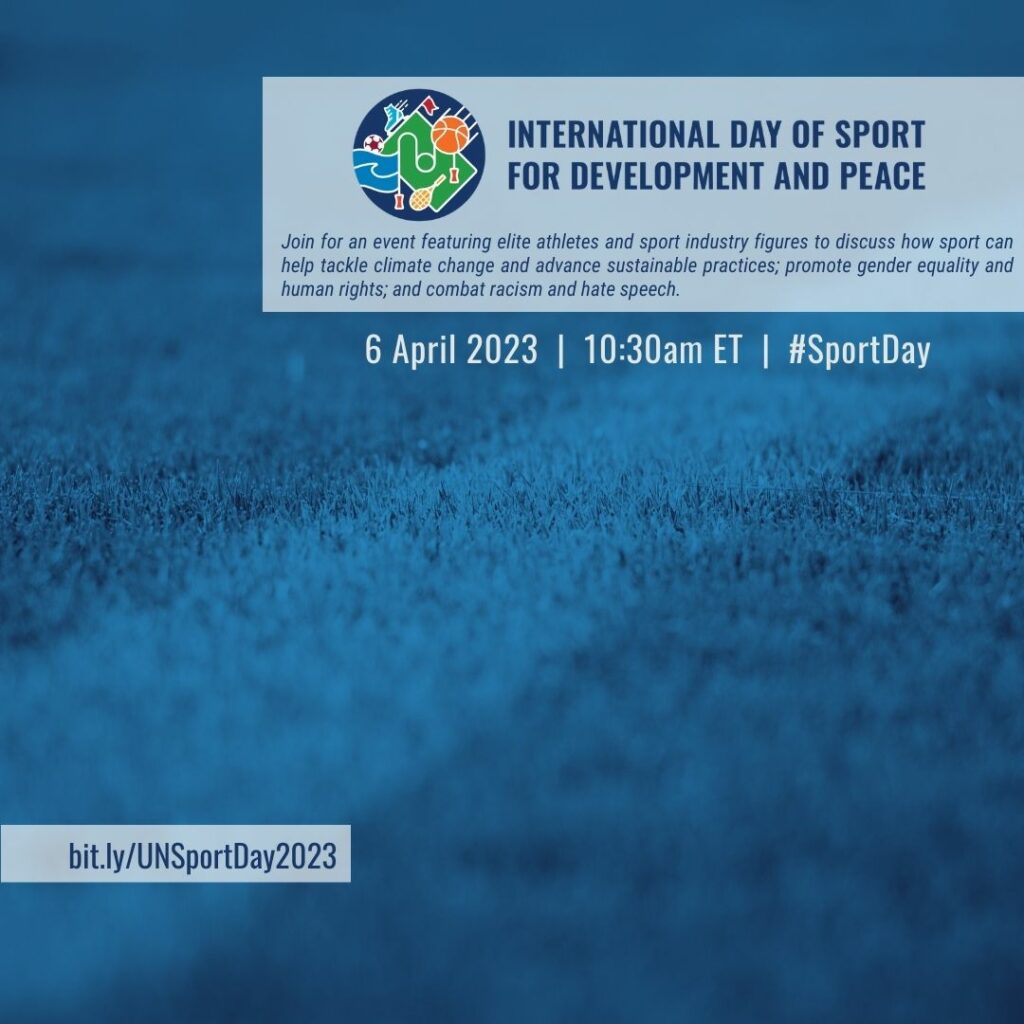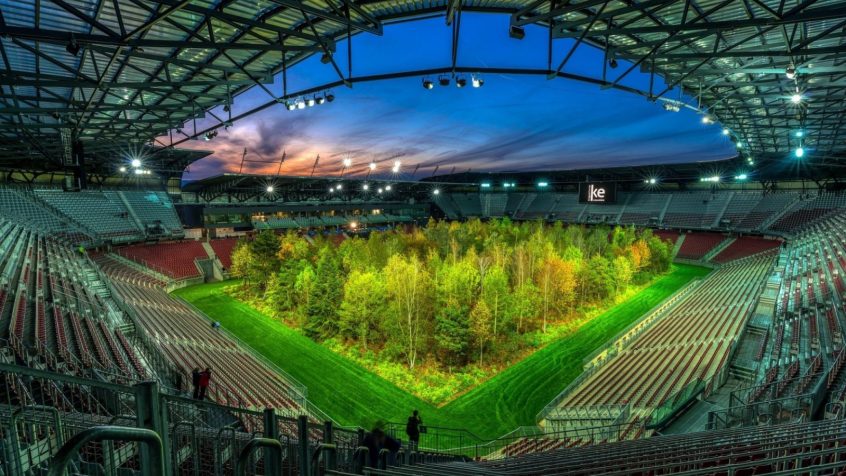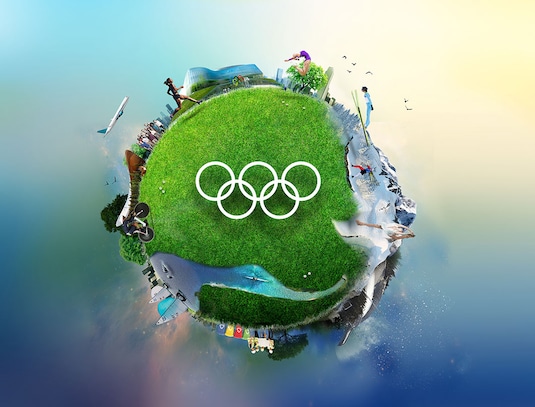Update
Sports, the Environment, and the Role of International Geneva
Sports and environment are intimately related, with one influencing the other in significant ways. As sport relies on clean air, moderate temperature, clean water, and healthy spaces for safe and enjoyable play, sports and sporting events can also impact the environment in negative ways. This update provides an overview of the relationship between the two, while presenting the role International Geneva can play in strengthening it.
Sports and the Environment
The relationship between the environment and sports is an intricate and symbiotic one, with each influencing the other in significant ways. Various athletic activities depend on well-preserved natural settings. In almost all sports it is important to become familiar with one’s natural environment, to develop a knowledge and appreciation of natural processes and features such as weather, water, soil, and snow conditions.
Although the history of most modern sports is characterized by a move away from nature to the artificial – in location, in equipment, in philosophy and in respect for the health of the athlete (Chernushenko, 1994) – these athletes are still very dependent on the environment, and the environment is very dependent on the way our sports are organized.
International Day of Sport for Development and Peace
6 April is International Day of Sport for Development and Peace, an opportunity to recognize the positive role sport and physical activity play in communities and in people’s lives across the globe, including the advancement of human rights, and social and economic development.
Sport has the power to change the world; it is a fundamental right and a powerful tool to strengthen social ties and promote sustainable development and peace, as well as solidarity and respect for all. With its close ties to environment, sports can also be an effective instrument to promote environmental protection and sustainability.
2023 Theme: Scoring for People and the Planet
The global theme for the International Day of Sport for Development and Peace 2023 highlights how sport offers tremendous potential for advancing the Sustainable Development Goals (SDGs) and for promoting peace and human rights: from empowering women and girls, young people, persons with disabilities, and other marginalized groups to advancing health, sustainability, and education objectives.
To mark the 10th anniversary of the day, the UN Department of Global Communications in collaboration with UN DESA, and the Permanent Missions of Monaco and Qatar to the UN is hosting an in-person event Thursday, 6 April 2023 at 10:30am ET in the ECOSOC Chamber at the UN Headquarters in New York. The event will also be live-streamed on UN WebTV and the UN YouTube channel, and the recording will be archived for on-demand viewing.
Impact of the Environment on Sports
From clean air, moderate temperature, clean water, and healthy spaces, sport relies on a clean, healthy and sustainable environment for safe and enjoyable play. For many generations, sport managers and participants have taken the natural environment for granted (Orr and Inoue 2019), developing complex dependencies in their supply chains, schedules, and systems which assume the natural environment will go unchanged. The reliance of sports on natural environments emphasizes the crucial role of maintaining a healthy planet, as the quality of these landscapes has a direct impact not only on athletes’ performance and experience but also on the successful management of sports events.
Sports activities, whether indoor or outdoor, are not immune to the impacts of climate change. Rising temperatures, melting ice, rockfalls, and warming oceans are all having profound consequences on the natural environments that support sports. Coastal erosion, storms, change to water current speeds, and flooding threaten water sports, while heatwaves affect outdoor activities and can impact the safety and performance of players. Winter sports such as skiing are particularly vulnerable, with reduced snowfall and extreme weather events.
- Sport For Nature: Setting A Baseline | UNEP | 2022
- Climate change: how does it affect sport? | Sport Heroes | 2021
- Sport and climate change—how will climate change affect sport? | Sven Schneider & Hans-Guido Mücke | 2021
Impact of Sports on the Environment
Sports have long been an integral part of human culture, offering entertainment, fostering a sense of community, and promoting physical fitness. However, the environmental impacts of sports cannot be ignored.
Environmental Impact of Sports Facilities and Events
Sports venues such as stadiums and complexes are an important part of modern sports culture. However, their development can have significant impacts on the environment. Clearing land for their construction can lead to the loss of ecosystems and biodiversity, while the energy and water resources consumed by these facilities can be significant, and they can generate large amounts of waste. Major international sports events, such as the Olympics or World Cups, also require the development of additional infrastructure, including highways and hotels, adding to the environmental harm caused by the events.
Furthermore, those global sport events often necessitate the construction of vast and specialized sports facilities but once these events end many of these structures are left underutilized or abandoned, as is the case of the Maracanã Stadium of the Rio 2016 Olympic games or of the Swimming Pool of Athens 2004 Olympic games, further exacerbating the environmental toll. As such, there is a growing demand for more sustainable planning and the repurposing of infrastructure to minimize the ecological consequences of these mega-events.
Nonetheless, mega-events can also sometimes serve as catalysts for positive change by stimulating the adoption of green initiatives and encouraging host cities to invest in enduring infrastructure enhancements. These upgrades, which include public transit systems and the development of urban green spaces, can yield long-term environmental benefits that persist beyond the event’s conclusion.
- During the 2004 Athens Summer Olympic Games, the city experienced a substantial expansion of its metro system.
- Air pollution reduction is another common positive outcome witnessed during mega-events. This was observed at the Athens Summer Olympics in 2004, the Beijing Summer Olympics in 2008, and the Rio Summer Olympics in 2016.
- Some studies also show that following mega-events, citizens often adopt more eco-friendly behaviours and embrace greener lifestyles. These changes can be attributed to the enhanced availability of green infrastructure, such as the widespread placement of recycling bins, the establishment of bike-friendly greenways, and the promotion of environmentally certified products and services.
More Resources:
- Paris 2024 Olympics to Set a New Standard with Single-Use Plastic Ban | One Planet Network | 1 June 2023
- The Environmental Impact of Major Sport Events (Giga, Mega and Major): A Systematic Review from 2000 to 2021 | Sergi Cerezo-Esteve & all | 2022
- Air quality monitoring assessment during the 2016 Olympic Games in Rio de Janeiro, Brazil | Luciana Maria Baptista Ventura & all | 2019
- Sustainability and the Olympics: The Case of Athens 2004 | G. Tziralis | 2008
Sports and Climate Change
There is an increasing acknowledgement of the connection between sport and climate change as sport both affects and is affected by this crisis. Although the influence of sporting organizations on climate is complex and hard to measure, it is broadly recognized that unsustainable practices in sport have further contributed to climate change.
Sports events themselves contribute to carbon emissions due to transportation, energy usage, and waste generation. There is an increasing acknowledgement of the connection between sport and climate change as sport both affects and is affected by this crisis. Although the influence of sporting organizations on climate is complex and hard to measure, it is broadly recognized that unsustainable practices in sport have further contributed to climate change.
According to the Rapid Transition Alliance’s report, the global sport sector contributes the same level of emissions as a medium-sized country. The carbon footprint from transportation to/from events, the construction and use of various sporting venues, and the supply chains for sport-related equipment all play an important role in affecting the world’s climate. For example, it has been estimated that the 2016 Rio Olympics released an estimated 3.6 to 4.5 million tons of carbon dioxide, while the 2018 Russia World Cup released 2.16 million tons.
What solutions are available?
The World Bank Group’s Connect4Climate, a global partnership program dedicated to climate change communication (initiated together with the Italian Ministry of Environment, the German Federal Ministry for Economic Cooperation and Development, in collaboration with about 500 knowledge partners) launched in 2014 the Sport4Climate initiative. The programme, started in collaboration with the Forum Das Americas, is a global communication campaign that showcases how sport is tackling global warming. Its initiatives include the “1.5C: the record we must not break” campaign, inaugurated in 2016, aiming at raising awareness in the wider audience around the 1.5°C goal set in the Paris Agreement.
The UN’s Sport for Climate Action Framework, launched in 2016 by the United Nations Framework Convention on Climate Change (UNFCCC) and some of the leading sport entities, has the aim of providing a systematic framework to the multiple, fragmented initiatives already in existence.
Addressing Climate Change Through Sport. UN DESA, 2022.
Sports and Nature
Our planet is also experiencing a nature crisis: Habitat destruction, invasive species, climate change and pollution are having an unprecedented impact on nature worldwide. Urgent action is needed by all of society, including the sports community, to halt and reverse the loss of biodiversity and the damage to the natural world on which we all depend to sustain our health and well-being, and provide clean air, fresh water and food.
The Sports for Nature Framework aims to deliver transformative nature-positive action across sports by 2030 and beyond, enabling sports to champion nature and contribute to its protection and restoration.
The Framework has been developed by the International Union for Conservation of Nature (IUCN), International Olympic Committee (IOC), United Nations Environment Programme (UNEP), in consultation with the Secretariat of the Convention on Biological Diversity (CBD), and in collaboration with sports organisations. It provides a game plan for sports — at all levels — to accelerate their action for nature, through their four principles:
- Protect nature and avoid damage to natural habitats and species;
- Restore and regenerate nature wherever possible;
- Understand and reduce risks to nature in your supply chains;
- Educate and inspire positive action for nature across and beyond sport.
Sports and Plastics
The sports industry relies extensively on the use of plastics. From the materials used in the fields, and stadiums to sports equipment, gear and clothing, plastics is ubiquitous in the sports industry. Plastics is seen to have added important performance benefits to the sports world, from being extremely light compared to other materials, like leathers used in balls or in tennis rackets, providing more predictable trajectories to balls, or ensuring the safety of children and adults in water environments through floatation devices. High levels of single-use plastics are employed by sports in the form of plastic bottles, merchandise, tickets and other hidden forms.
Plastic pollution from the sports world not only contributes to aggravating the global crisis but can also have negative impacts on the sports industry. Initiatives to curb their impact have been taken at the international and even local levels in recent years.
In 2018, the International Olympic Committee joined the United Nations Environment Programme (UNEP) Clean Seas Campaign and pledged to beat plastic pollution by eradicating single-use plastics from its events and raising awareness on the topic. In 2020, IOC and UNEP launched together a guide to reduce the plastic footprint of the sports industry. Relying on the reduction of single-use items, improved recycling efforts and use of the sports sector visibility and outreach to create public awareness on the importance of tackling plastic pollution, the guide offers a toolkit to sports events organizers and attendees based on five Rs: Refuse; Reduce; Reuse; Replace; Recycle; Remind.
As a part of its policy to reduce plastic pollution, in January 2020 the City of Geneva banned all organization using its sports facilities from using single-use plastics.
More Resources:
- 10 ways the world of sport is tackling plastic pollution | UNEP | 2018
- Sports & Leisure | Plastics Europe
- Plastics and the Environment | GEN Update
Role of International Geneva
Geneva is an important hub for international environmental governance, and is surrounded with international sports federations, and academies and organizations that deal with sports. Therefore, Geneva is the perfect place to find synergies between sports and the environment, and in understanding why sports need a clean and healthy environment to exist, as well as what sports can bring to the protection of the environment.
International Organizations and Federations
European Athletics Association (EAA)
The EAA is the governing body for athletics in Europe, which runs and regulates several championships and meetings across the continent – both indoor and outdoor. As part of their sustainability program, they have created an internal sustainability charter, entitled “Our Green Lifestyle”, for resource conservation, reducing environmental waste. They also aim to help all levels of the sport to promote sustainability and integrate good practice through the 8-Step Quick Guide and extensive online sustainable event management guide, including Sustainability Roadmap and Green Sports Hub Europe.
Fédération Aéronautique Internationale (FAI)
The FAI is a non-governmental and non-profit international organization with the basic aim of furthering aeronautical and astronautical activities worldwide, ratifying world and continental records and coordinating the organization of international competitions. In 1995, the Federation has established the Environmental Commission (EnvC) has been created to study all air sports interaction with parts of the environment, considering air, land, sea, water, scenic views, wildlife, vegetation. One of the commission’s work is the development of facilities and the carrying out of air sport activities are to be conducted in a manner that harmonizes the interaction between the air sport activities and the environment.
Federation Internationale de l’Automobile (FIA)
The FIA is the governing body of motor sport and promotes safe, sustainable and accessible mobility for all road users across the world. They also govern many auto racing events, including Formula One. The Federation aims to make Motor Sport to be sustainable and Mobility to contribute to global environmental and sustainable agenda targets, through the introduction of hybrid engines in Formula 1, the creation of Formula E (the world’s first fully electric motor sport championship), ongoing research into environmentally friendly fuels, the establishment of the Environment and Sustainability Commission, and our adhesion to the United Nations Sport for Climate Action Framework.
Fédération Internationale de Motocyclisme (FIM)
The FIM is the global governing/sanctioning body of motorcycle racing. Since 1994, the Federation has aimed to enforce policies that address the environment through its International Sustainability Commission (CID) and the FIM Environmental Code.
Foundation Bertarelli
Founded in 1998, the Foundation Bertarelli is a Swiss-based private foundation that tackles some the biggest issues in the fields of marine conservation and life science research and does so by developing partnerships with scientists, NGOs and governments around the world. As a result the Foundation is helping to provide real solutions to critical problems ranging from combating illegal-fishing to overcoming congenital deafness.
The foundation also contributes significantly to sports education. A fund of 150,000 Swiss Francs is distributed every year to the Swiss Sailing Federation to enable it to support projects in the “elite”, “junior” and “social action” categories. With a proud tradition of sailing in the country – particularly in the Lake Geneva region – the aim of these grants is to enable the Federation to support its young and future stars, firing their interest, supporting their goals and giving them the platform to compete on an international level.
International Academy of Sport Science and Technology (AISTS)
The Lausanne-based AISTS aims to bring a positive contribution to the management of sport through post-graduate and executive education, as well as applied research, consulting and services by developing, integrating and delivering multidisciplinary knowledge from human sciences, life sciences and engineering sciences. They offer a programme on Managing Sport Sustainability, which is designed to provide a comprehensive and critical review of organisations’ interpretation of social responsibility and sustainability issues and the need to manage social and environmental performances.
International Organization for Standardization (ISO)
The ISO is an independent, non-governmental international organization with a membership of 166 national standards bodies. Through its members, it brings together experts to share knowledge and develop voluntary, consensus-based, market relevant International Standards that support innovation and provide solutions to global challenges. When it comes to sports, ISO provides standardization guidelines on various sports and other recreational facilities and equipment (ISO/TC 83) as well as on organizing sustainable events (ISO 20121).
International Olympic Committee (IOC)
The International Olympic Committee is an international organization based in Lausanne, that is at the very heart of world sport, supporting every Olympic Movement stakeholder, promoting Olympism worldwide, and overseeing the regular celebration of the Olympic Games.
The IOC has developed a Sustainability Strategy which includes climate action among its focal areas. The IOC aims, by 2030, to move beyond carbon neutrality and make the games carbon negative. With this goal, it has set a “Strategic intents for 2030” plan which entails a reduction of both direct and indirect greenhouse gas emissions for operations and events associated with the Olympic Movement’s activities, and an adaptation to the consequences of climate change in the planning of sport facilities and events.
The IOC understands he need for a more sustainable world and that it is one of the greatest challenges of our time. We believe the IOC […] has both an opportunity and a duty to actively contribute to global sustainability. Our vision “Building a better world through sport” attest to this and supports the IOC’s actions.
Commitment to climate action is now also one of the requirements for candidate cities to host the Olympic Games. This has contributed to the recent Tokyo 2020 summer Olympics strategy for climate action, which entailed, for instance, the use of pre-existing buildings (60 percent of all facilities were from pre-existing buildings), the use of renewable energy for games and operations, and the enaction of a carbon offset program
International Union for Conservation of Nature (IUCN)
Seeing the urgent need to act across all parts of society, the IUCN has identified sports to be a unique opportunity to address the nature crisis. As such, the IUCN has been working with key partners on developing a Sports for Nature Framework to contribute to global efforts to halt and reverse biodiversity loss by 2030 by engaging with the sports community.
In October 2022, the IUCN and Sails of Change have also announced a new partnership to help sports organisations mitigate negative impacts on biodiversity and climate and encourage them to take concrete steps to protect biodiversity.
Union of European Football Associations (UEFA)
UEFA is the governing body of European football and the umbrella organization for 55 national associations. As challenges in the field of human rights and the environment are gaining importance in society and football, UEFA has created a sustainability roadmap to building a more sustainable future for European football, including Sustainable Infrastructure Guidelines which aims to raise the bar in European football venues.
World Archery
World Archery was founded in 1931 to regulate and promote the sport of archery. To support environmental sustainability, the federation has joined the Sport for Climate Action United Nation’s initiative and signed the Climate Neutral Now pledge. Since 2020, World Archery has claimed to offset all its unavoidable carbon emissions.
World Rowing (FISA)
World Rowing, formerly known as Fédération Internationale des Sociétés d’Aviron, is the governing body of the sport of rowing. As the international federation and global custodian of the sport of rowing, World Rowing is dedicated to use the power of sport to bring about positive change by activating and inspiring its communities to act, and contributing its share in the following UN Sustainable Development Goals. It does so its “sustainability raise plan” which is outlined in its six principles: clean water, biodiversity, responsible consumption, climate action, diversity, inclusion, fair and equitable treatment, and partnerships, education and grassroots activism.
Local Organizations and Initiatives in Geneva and Surroundings
Fête du sport
La Fête du sport was organized for the first time in 2022 by the Geneva Association of Sports (Association genevoise des sports), the Canton of Geneva and the City of Geneva. As a part of the event, a plogging and clean-up initiatives were held to raise awareness on the impact of waste on the environment.
Fondation Pacifique
Fondation Pacifique is a Geneva-based non-profit organization founded in 2021 committed to raise awarenes on the human impact on the ocean and how to protect it. Fondation Pacifique designs, organizes and conducts multidisciplinary ocean expeditions on traditional sailboats with the purpose of Sailing for Science, Education and Sustainability.
EcoTrail Geneva
EcoTrail is an initiative that reached Geneva in 2015 and which combines the discipline of trail running with respect of the environment and uses sports demonstration as a way to raising awareness about the impact each runner has on the environment. The next Eco Trail running events will take place on 10 June 2023.




